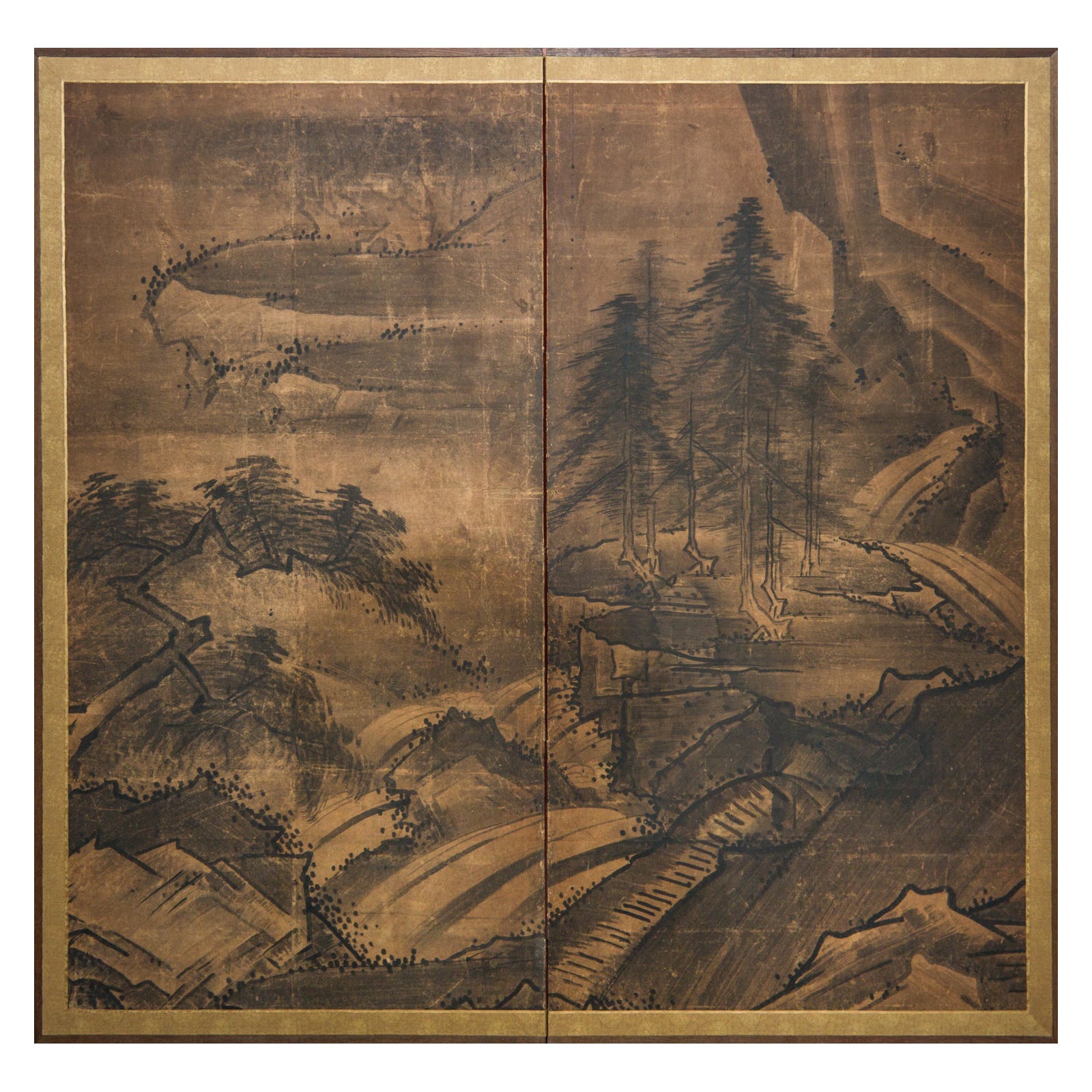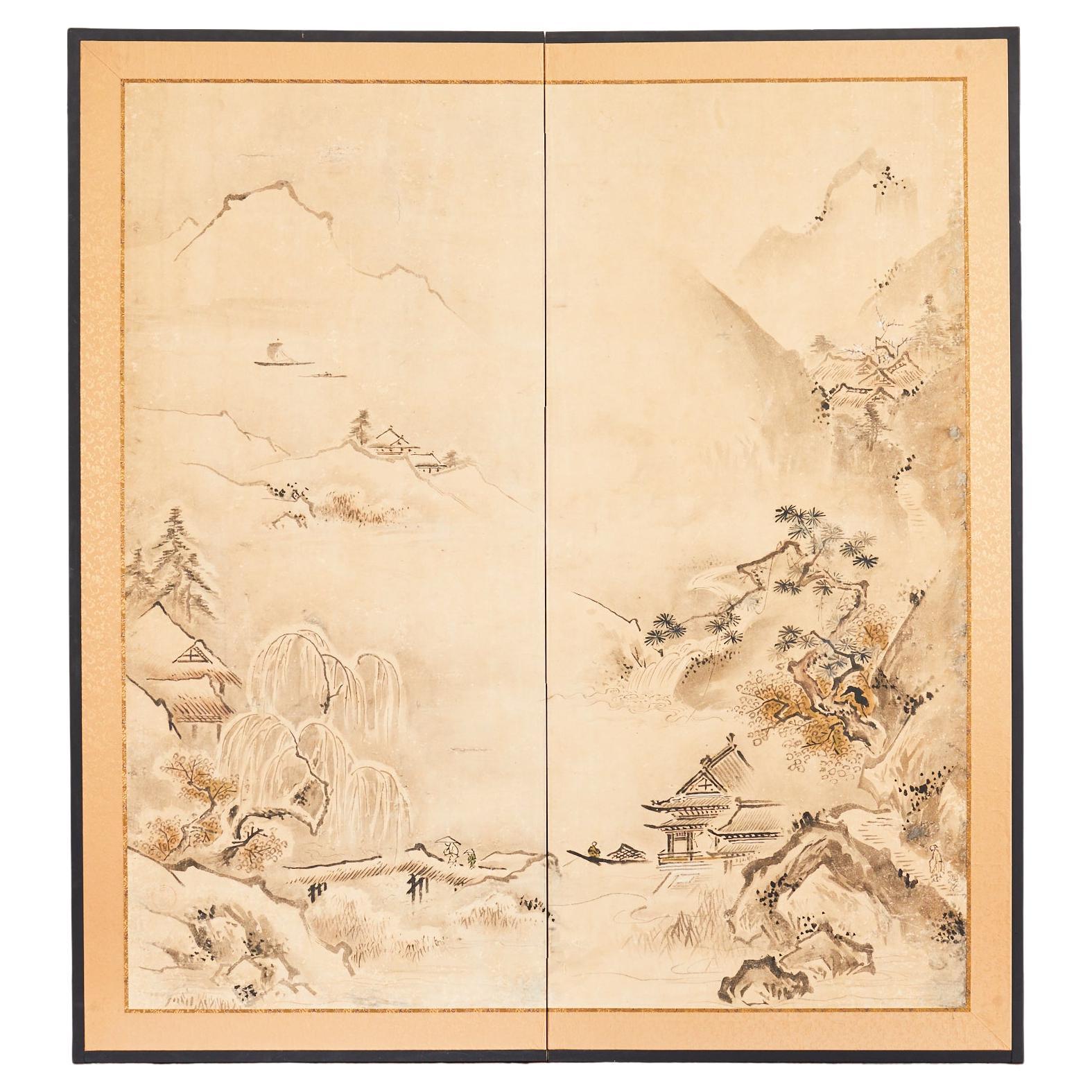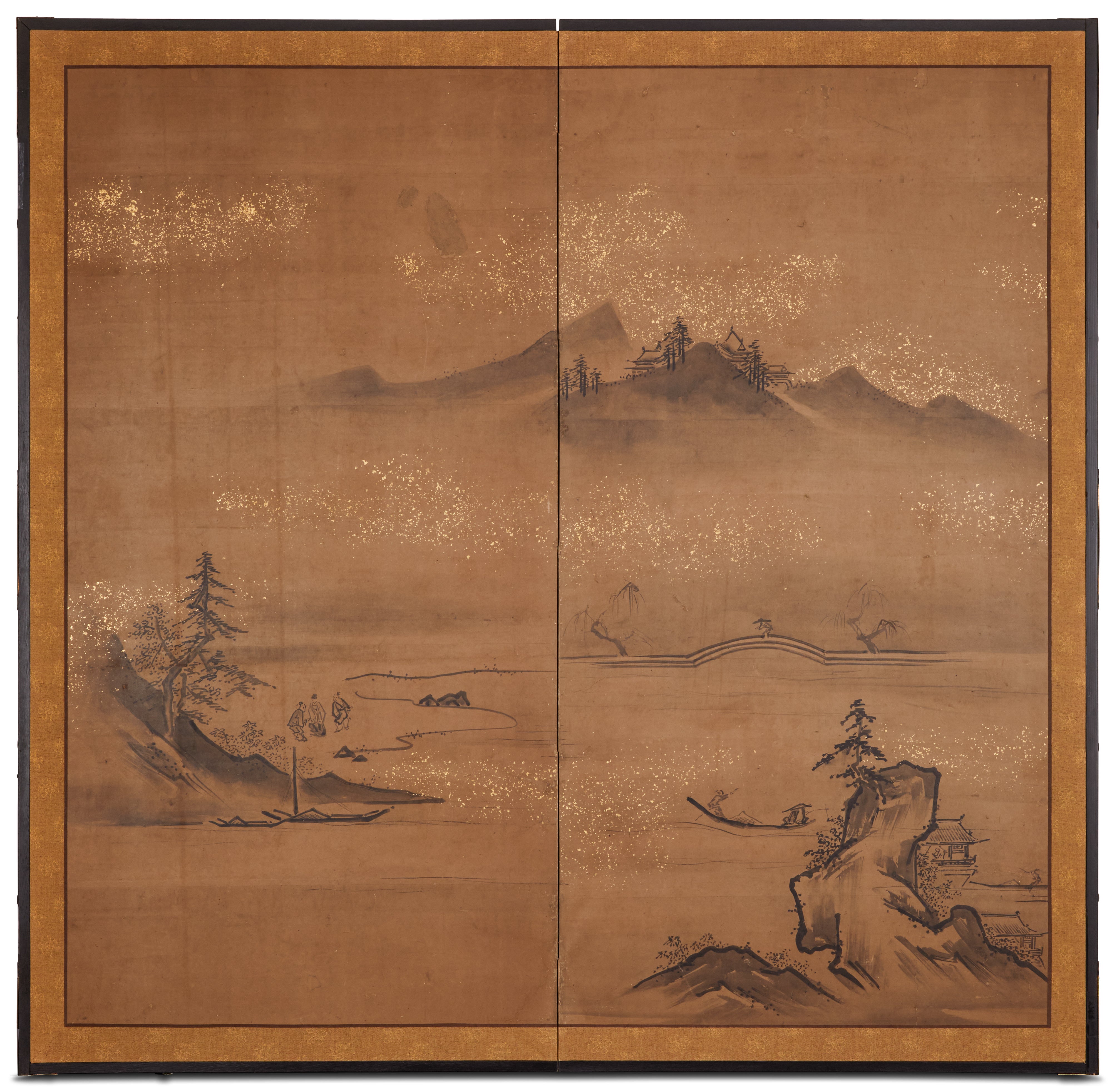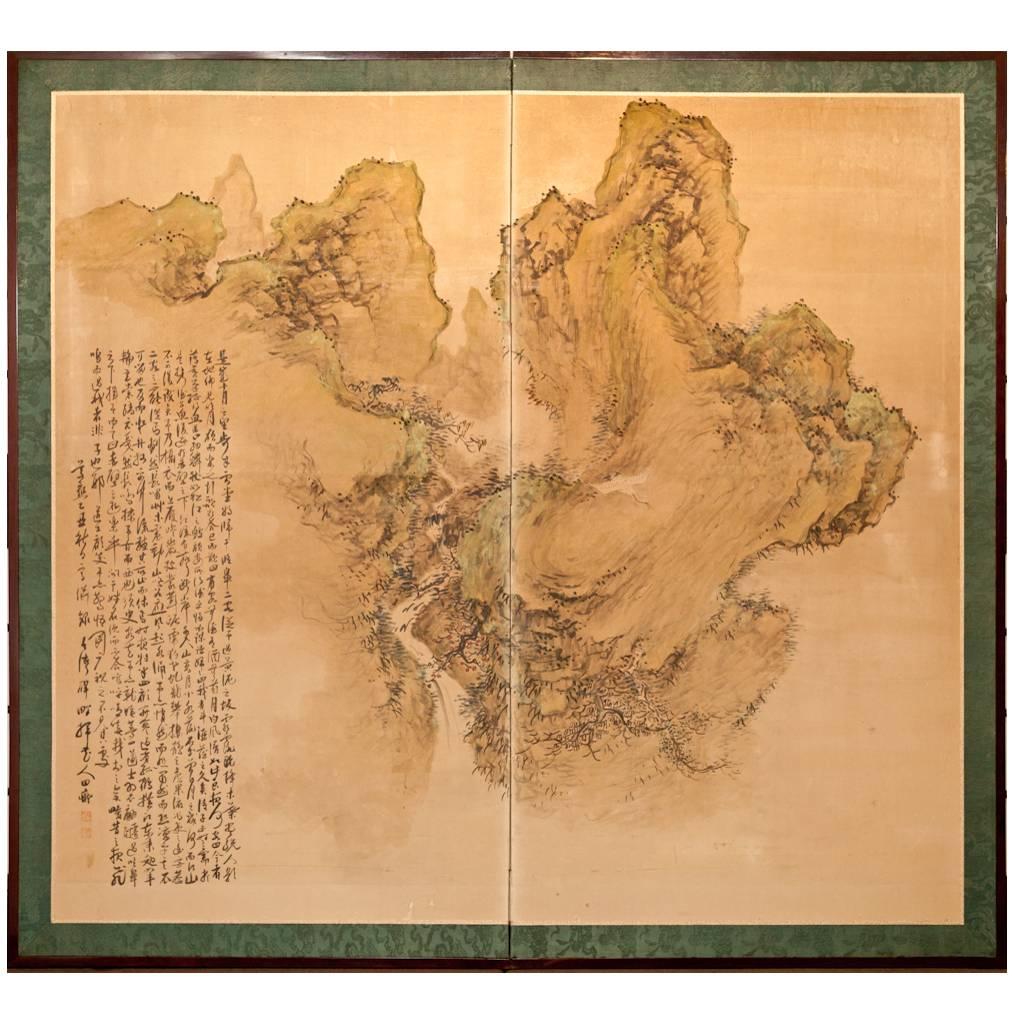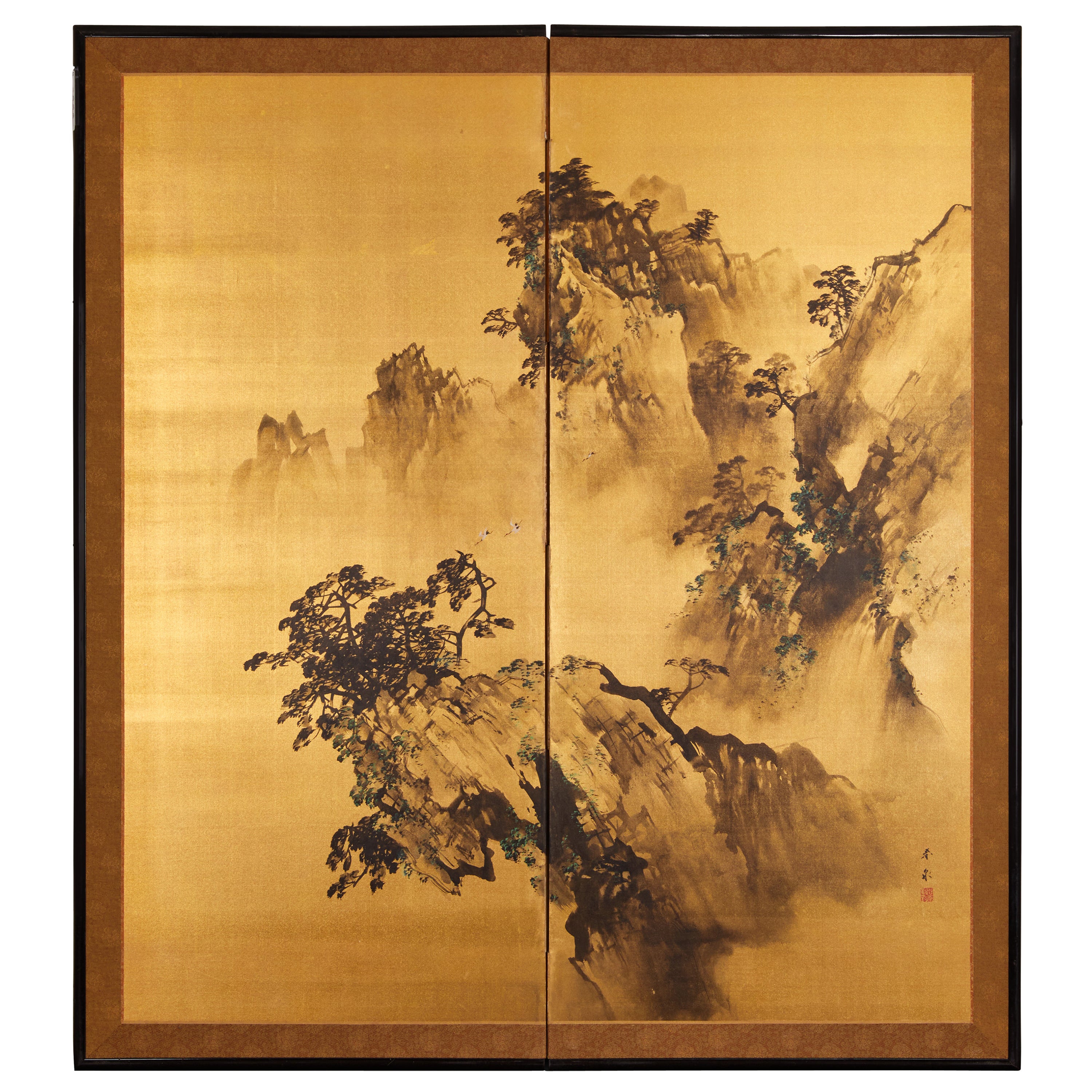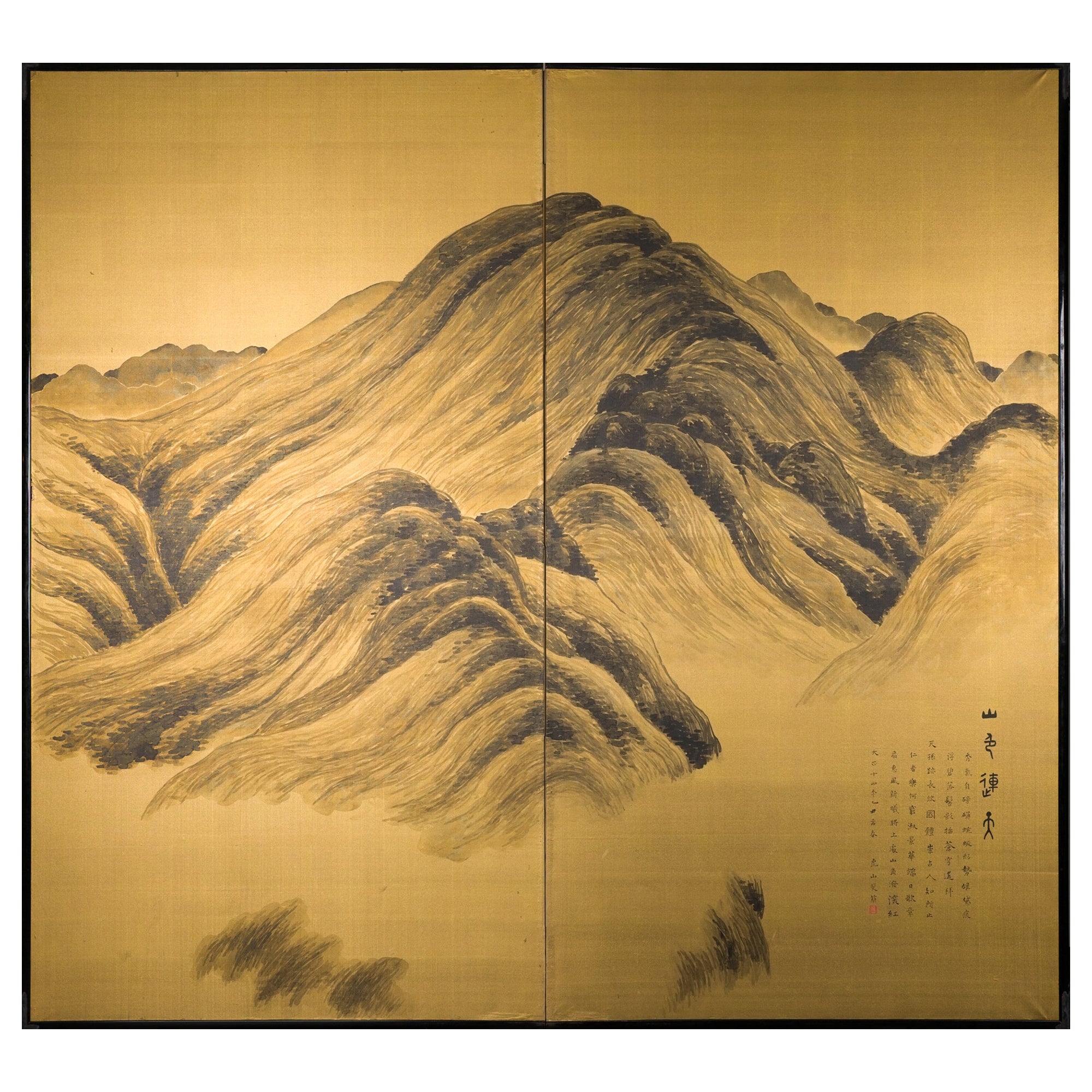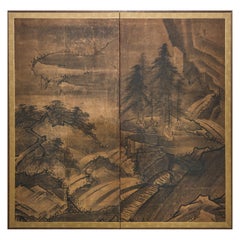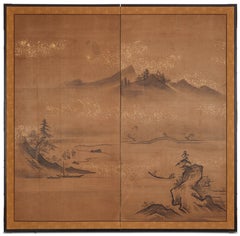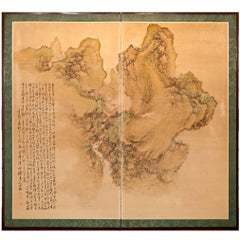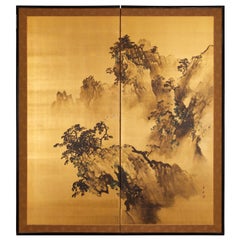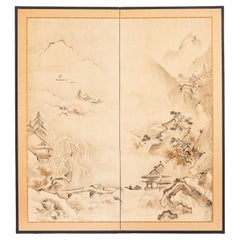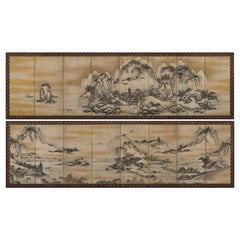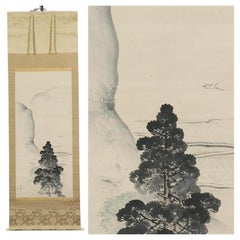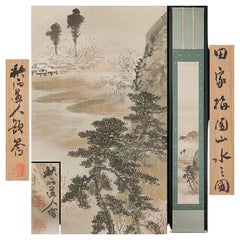Items Similar to Japanese Two-Panel Screen: Ink Landscape on Silk
Want more images or videos?
Request additional images or videos from the seller
1 of 5
Japanese Two-Panel Screen: Ink Landscape on Silk
$12,500
£9,297.89
€10,885.99
CA$17,441.75
A$19,517.80
CHF 10,191.28
MX$239,951.06
NOK 128,574.74
SEK 120,988.19
DKK 81,217.82
Shipping
Retrieving quote...The 1stDibs Promise:
Authenticity Guarantee,
Money-Back Guarantee,
24-Hour Cancellation
About the Item
Japanese Two Panel Screen: Ink Landscape on Silk, Meiji period (1868 - 1912) painting of a man riding a mule on a pathway through the Kurotani mountains with a thatched roof shelter on the right. Signed: Shunyu. Ink painting (sumi-e) on silk with a silk brocade border.
- Creator:Shunyu (Designer)
- Dimensions:Height: 67.75 in (172.09 cm)Width: 74.5 in (189.23 cm)Depth: 0.75 in (1.91 cm)
- Style:Meiji (Of the Period)
- Materials and Techniques:
- Place of Origin:
- Period:
- Date of Manufacture:circa 1880
- Condition:Condition report upon request.
- Seller Location:Hudson, NY
- Reference Number:Seller: S13341stDibs: 1204238551648
About the Seller
5.0
Recognized Seller
These prestigious sellers are industry leaders and represent the highest echelon for item quality and design.
Established in 1971
1stDibs seller since 2008
166 sales on 1stDibs
Typical response time: 7 hours
Associations
The Art and Antique Dealers League of AmericaAntiques Associations Members
- ShippingRetrieving quote...Shipping from: Hudson, NY
- Return Policy
Authenticity Guarantee
In the unlikely event there’s an issue with an item’s authenticity, contact us within 1 year for a full refund. DetailsMoney-Back Guarantee
If your item is not as described, is damaged in transit, or does not arrive, contact us within 7 days for a full refund. Details24-Hour Cancellation
You have a 24-hour grace period in which to reconsider your purchase, with no questions asked.Vetted Professional Sellers
Our world-class sellers must adhere to strict standards for service and quality, maintaining the integrity of our listings.Price-Match Guarantee
If you find that a seller listed the same item for a lower price elsewhere, we’ll match it.Trusted Global Delivery
Our best-in-class carrier network provides specialized shipping options worldwide, including custom delivery.More From This Seller
View AllJapanese Two Panel Screen Suiboku Landscape in Sesshu Style
Located in Hudson, NY
Suiboku is a style of ink painting that is reminicent of the way calligraphers paint. Masterfully painted Muromachi Period (1336-1573) painting, unique in style and strength for the period with very bold lines. Sesshu Toyo...
Category
Antique 16th Century Japanese Paintings and Screens
Materials
Silk, Paper
Japanese Two Panel Screen, Ink Landscape on Paper with Gold Dust
Located in Hudson, NY
Sesshu-style painting in ink on mulberry paper with gold dust accents and a silk brocade border.
Category
Antique 19th Century Japanese Paintings and Screens
Materials
Gold
Japanese Two Panel Screen: Mountain Landscape with Calligraphy
Located in Hudson, NY
Japanese Two Panel Screen: Mountain Landscape with Calligraphy. Late Edo (c. 1850) painting of a dramatic mountainside carved by a waterfall with a crane flying in the foreground an...
Category
Antique Mid-19th Century Japanese Edo Paintings and Screens
Materials
Silk, Wood, Paper
Japanese Two Panel Screen: Craggy Landscape on Gold Sil
Located in Hudson, NY
Dramatic Mountain landscape with gnarled pines. Signature reads: Shunsen. Ink painting on gold silk with silk brocade border.
Category
Early 20th Century Japanese Paintings and Screens
Materials
Brocade, Silk
Japanese Two Panel Screen Mountain Landscape on Gold Silk
Located in Hudson, NY
Nanga School; by female artist Kia Kozan. Showa Period (1926-1989) Translation: Kai Kozan 1867-1961, from Bungo area in Kyushu. Graduated from Bunchu-en Girls School. Signature and s...
Category
Mid-20th Century Japanese Paintings and Screens
Materials
Paper
Japanese Two Panel Screen: Mountains in the Mist
Located in Hudson, NY
Chinese School landscape ink painting on gilded silk by Yukimatsu Shunpo, signed and dated 1924. Yukimatsu Shunpo was born in Oita in 1897 and studied under Himejima Chikugai in Osak...
Category
Early 20th Century Japanese Taisho Paintings and Screens
Materials
Silk
You May Also Like
Japanese Meiji Two-Panel Screen Chinese Country Winter Landscape
Located in Rio Vista, CA
Late 19th / early 20th century Japanese Meiji period two-panel folding byobu screen featuring a winter landscape with a Chinese country villa and distant village. Kano School screen ...
Category
Antique 19th Century Japanese Meiji Paintings and Screens
Materials
Brass
17th Century Japanese Screen. View of West Lake by Unkoku Toyo.
Located in Kyoto, JP
Unkoku Toyo (1612-1668)
View of West Lake
Pair of eight-panel Japanese Screens. Ink and gold wash on paper.
Dimensions: Each screen: H. 110 cm x W. 372 cm (43” x 147”)
This pair ...
Category
Antique Mid-17th Century Japanese Edo Paintings and Screens
Materials
Paper
Japanese Nihonga Painting 19th c Edo Scroll by Seiki Yokoyama Landscape Shijo
Located in Amsterdam, Noord Holland
[Authentic work] ◆ Seiki Yokoyama ◆ Landscape ◆ Rural landscape ◆ Japanese painting ◆ Shijo school ◆ Hand-painted ◆ Paperback ◆ Hanging scroll ◆
Seiki Yokoyama
[Art yearbook appra...
Category
Antique 19th Century Edo Paintings
Materials
Silk
$1,240 Sale Price
20% Off
Japanese Nihonga Painting 1900 Meiji/Taisho Scroll Shûseki, Okutani Landscape
Located in Amsterdam, Noord Holland
Susheki Okutani "Takaya Plum Garden Landscape"
Silk, Colored, Authentic, Hanging Scroll, , Double Box
size Axis: Height 206.5cm Width 29.3cm
Drawing…Height 126.7cm Width 19.5cm *There may be slight differences in dimensions. Thank you for your understanding.
situation It is in good condition, but please note that there are some light stains.
Please check the image for details.
Thank you for your support.
Biography Akishi Okutani
Japanese painter. Born in Osaka. His name is Tsunejiro. He studied under Kansai Mori. From an early age, he exhibited his works at the Japan Painting Association and the Young People's Painting Association, which was led by Gaho Hashimoto and Gyokusho Kawabata, and won numerous awards. He also opened a private school...
Category
20th Century Taisho Paintings
Materials
Silk
$1,718 Sale Price
20% Off
Japanese Nihonga Painting 19th c Edo Scroll by Tonomura Chokunyu River landscape
Located in Amsterdam, Noord Holland
[Authentic work] ◆Tanomura Chokunyu ◆Ink painting landscape ◆Japanese painting ◆Handpainted ◆ Paper ◆ Hanging scroll ◆
Chokunyu Tanomura
1814 (Bunka 11) - 1907 (Meiji 40)
[Art yearbook appraised value 8 million yen]
"A child prodigy in painting, Tanomura Chokunyu originally modeled himself after the style of the famous Tanomura Chikuden (1777-1835), who had adopted him at the age of eight. After Chikuden's death, Chokunyu took up an intense study of imported Chinese paintings." Paul Berry in: Literati Modern, p.136.) - The certificate box was inscribed by Tajika Chikuson (1864-1922), one of Chokunyu's key disciples.
Around 1840, he studied Confucianism under Kotake Shinozaki in Osaka, deepened his friendships with Heihachiro Oshio and Tessai Tomioka through sencha, and began to be recognized as a painter.
Furthermore, in 1862, he founded and hosted the Seiwan Tea Ceremony (a sencha tea ceremony), which achieved great fame.
In 1868, he moved to Kyoto and participated in the establishment of the Kyoto Prefectural Painting School (opened in 1880), serving as its principal and making efforts to foster the next generation.Furthermore, in 1996, he established the Japan Nanga Association with Tessai and others, and established the Japan Nanga Association, which was established in modern Japan. He made a great contribution to painting and the southern painting...
Category
Antique 19th Century Edo Paintings
Materials
Silk
$1,718 Sale Price
20% Off
Japanese Painting 18c Edo Scroll Chikuseki Nagamachi Nihonga Landscape Painting
Located in Amsterdam, Noord Holland
[Authentic Artwork] ◆ Nagamachi Chikuseki ◆ Landscape ◆ Edo Period ◆ Mitsuishi Origin ◆ Kagawa Prefecture ◆ Handwritten ◆ Paperback ◆ Hanging Scroll ◆ k891 ◆ Nagamachi Chikuseki
Explore the artistry of Chikuseki Nagamachi...
Category
Antique 18th Century Edo Paintings
Materials
Silk
$1,813 Sale Price
20% Off
More Ways To Browse
Chinese Round Black Lacquer Screen Room Divider
Chinese Torture Paintings
Coromandel Chinese Lacquer Screen 4 Panel
Frida Escobedo
Japanese Reed Screens
Japanese Sudare
Koi Fish Silk Painted Screens
Maitland Smith Warriors
Mashrabiya Screen
Philippine Capiz Shells
Philippine Skirt
Qian Yang
Sandalwood Fan
Shiryu Morita
Suzuki Shonen
Tibetan Tiger Box
Tibetan Wardrobe
Zhao Shao Ang
